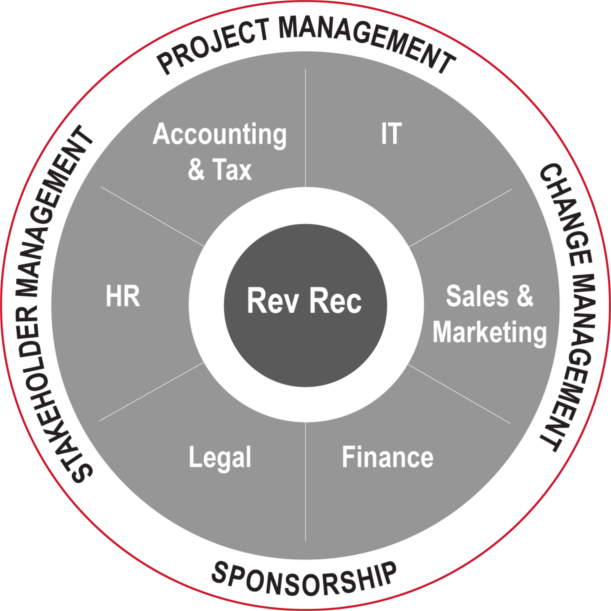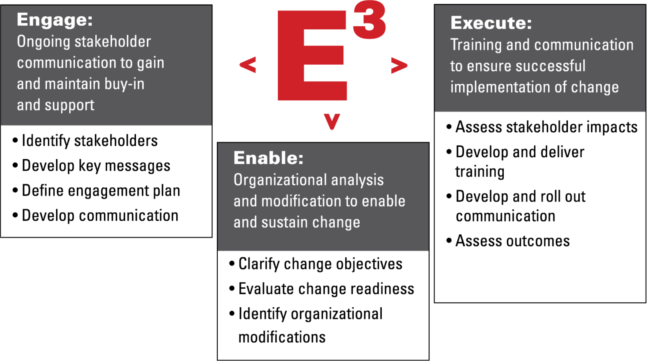If not already known, companies are learning that the new Revenue Recognition standard can have enterprise-wide impacts that affect core business functions and their associated systems and data. Because so many parts of a business are tied to revenue, the new guidance is pervasive touching everything from executive and sales compensation to how products are sold, and how work is done. Systems and processes will need to change to accommodate the compliance process, and people will need to be trained on the new standard, as well as the associated policies, work processes and systems. Communications will be essential to ensure stakeholder understanding, both inside and outside the company.
The importance of organizational change management
Multiple Revenue Recognition engagements have taught us to understand the technological and operational impacts in addition to the people implications of change efforts with a holistic approach.

Most change efforts fail. According to a recent
CEB study, “many organizations fail to implement change effectively. In fact, only one-third of change efforts are clear successes: 16% show mixed results, and half are clear failures”. However, a study by independent research company Prosci “found that initiatives with excellent change management are
six times more likely to meet objectives than those with poor change management”. A holistic approach to organizational change management (OCM) or the “people side” of the project is core to the successful transition to the new Revenue Recognition standard.
Ultimately, OCM is all about helping impacted employees through the transition; minimizing resistance, loss of productivity and business disruption.
Lessons learned
 Engage
Engage Top leaders need to own, vocalize and “walk the talk” of transformation. However, the manner in which individuals ultimately transition to the future state is more dependent on the hearts and minds of their immediate leader. Equipping those front-line leaders with tools and knowledge to coach their teams through change helps achieve it without resistance. Their ability to explain how and why their team members will be impacted (emphasizing the positive) makes them part of the solution and will determine whether the team owns the change, rather than the change being forced on them.
Enable • Program and Portfolio Change Management Rationalizing change across the program means managing individuals’ experiences to change. Thoughtfully packaging changes from across the program and orchestrating communication and training to energize, and not exhaust, stakeholder groups makes multi-year, multi-faceted change easier for individuals to accommodate. Continuously peppering individuals from different parts of the program or slamming them all at once is a recipe for exhausting stakeholders before getting to the finish line. Stress from the quantity of change, frustration with the process (and not just the specific change) and misunderstanding how it all fits together results from ineffective timing and communication from the whole program. Furthermore, awareness and orchestration needs exist at a change portfolio level to address stakeholder groups who are experiencing additional changes outside of the specific transformation program.
• Change Agent Network A formal change agent network provides critical input to understand the type and amount of information that individuals need. An effective change agent network is as much about receiving feedback as about creating an additional (in addition to top-down) communication vehicle. Change agent networks can provide texture to the information that is gathered in surveys and be a ready focus group for testing processes and approaches. Engaging resistors in the change agent network is an important approach as they can predict how others who are prone to resist will react.
• Urgency Message It is important to clearly and succinctly explain why the transformation has to be done and its positive impact. The why should include “why now” and “why this way.” The challenge is to keep the urgency message fresh while reiterating it early and often throughout the life of the program. It is too easy for program team members to get bogged down in the details of implementation and forget the reason for the transformation. Stakeholders who are not part of the program team need to be reminded regularly about the urgency and benefits driving the initiative along with updates of what is being accomplished. The longer and more involved the program is, the greater the need to use a well-crafted urgency message to keep momentum for stakeholders and the program team. Always assume people have to be reminded, “why”.
• Energize Along the Way Communicate quick wins, celebrate milestones, recognize the work of the project team and individuals, etc.
Execute By engaging and enabling leaders and the employees that are impacted by Revenue Recognition early and throughout each phase of the project you will increase the likelihood of a successful transition. The leaders’ role in reinforcing updated processes, procedures and new ways of operating are critical to optimizing the implementation of the new Revenue Recognition standard.
View all of our Revenue Recognition insights and learn more about our capabilities here.
Shauna Watson, CPA, is the Global Managing Director, Finance & Accounting at RGP. Danielle Cordy, Ph.D., is the Senior Director, Human Capital & Change Management at RGP. Rudy Lacayo, CCMP, is the Managing Consultant, Human Capital at RGP.
About RGP RGP is a global consulting firm that provides advice and execution to clients of all shapes and sizes in more than 70 countries—including 87 of the Fortune 100. With a Big Four heritage, its 3,000+ accomplished professionals offer deep expertise across a broad range of integrated services. RGP provides its clients the agility to expand capacity and increase capability. And the support they rely on to help them achieve all that’s possible.